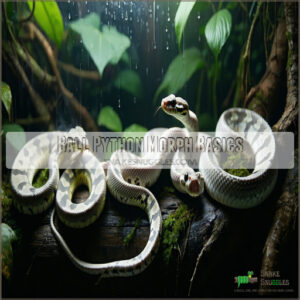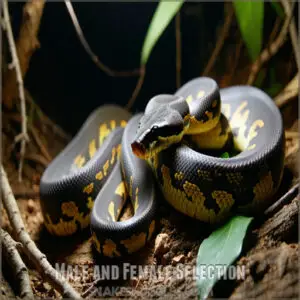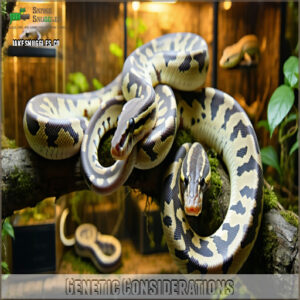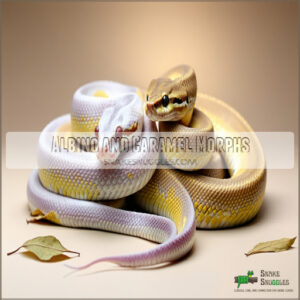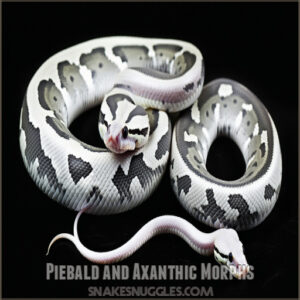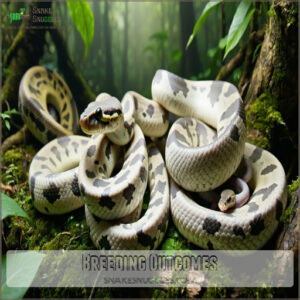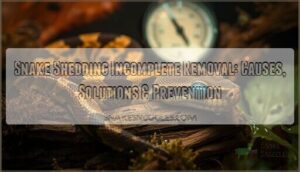This site is supported by our readers. We may earn a commission, at no cost to you, if you purchase through links.
 You’re about to enter the fascinating world of morph combinations ball python breeding genetics, where over 4,000 possible combinations await.
You’re about to enter the fascinating world of morph combinations ball python breeding genetics, where over 4,000 possible combinations await.
Think of it as solving a living puzzle – each gene plays a unique role in creating stunning colors and patterns.
You’ll need healthy pythons (females over 1,500g), precise temperature control (88-92°F), and proper humidity (60-80%) to succeed.
Dominant genes show up with just one copy, while recessive genes need two to shine.
Using tools like Punnett squares and the Genetics Wizard, you can predict which morphs will spark in your next clutch.
Table Of Contents
- Key Takeaways
- Ball Python Morph Basics
- Breeding Ball Pythons
- Genetic Considerations
- Morph Combinations
- Breeding Outcomes
- Frequently Asked Questions (FAQs)
- What ball python morphs are recessive?
- Is axanthic recessive or dominant?
- Is Ghi a dominant gene?
- Is pinstripe a dominant gene?
- How much does it cost to start breeding morphs?
- What age can ball pythons start producing eggs?
- Which morph combinations have the highest market value?
- Can different ball python localities be crossbred safely?
- How many eggs typically survive in a clutch?
- Conclusion
Key Takeaways
- You’ll need to understand dominant, recessive, and codominant genes to predict and create stunning ball python morph combinations.
- Proper care is essential for successful breeding, including healthy breeders, temperatures of 88-92°F, and 60-80% humidity.
- Tools like Punnett squares help you calculate and plan morph outcomes with accuracy.
- Avoid inbreeding by maintaining genetic diversity through outcrossing and tracking lineage for healthier offspring.
Ball Python Morph Basics
You’ll discover how genetic variations create the stunning colors and patterns that make ball python morphs unique and valuable.
When you understand the basics of dominant and recessive genes, you’ll discover the secret to breeding over 4,000 possible morph combinations.
Genetic Variations
A fascinating world of genetic variations awaits you in ball python morphs, where each unique pattern tells a story of mutation and evolution.
You’ll discover an incredible range of possibilities through gene expression and trait inheritance.
Here’s what makes these variations special:
- Genetic drift creates over 4,000 distinct color and pattern combinations
- Mutation rates continuously produce new morph variations
- Heritability factors determine how traits pass to offspring
- Single-gene mutations originate from rare wild specimens
- Loss-of-function variants contribute to diverse phenotypes
The study of ball python genetics involves examining genetic color morphs to understand the underlying causes of these variations.
Dominant and Recessive Genes
You’ll quickly grasp ball python genetics once you understand how genes play their cards.
In dominant traits, you’ll see the effect with just one copy – like the Spider morph’s striking pattern.
Recessive traits need two copies to show up, playing hide and seek until both parents contribute the same gene.
It’s like a genetic poker game where some hands always win, while others need matching pairs, and understanding this can help you master ball python genetics.
Color and Pattern Combinations
Ball python morphs‘ color genetics create a mesmerizing array of possibilities.
You’ll discover over 4,000 unique combinations when pattern mixing different morphs, from vibrant albinos to striking piebalds.
Scale variations contribute to distinct visual appearances, while genetic traits determine how colors and patterns blend.
Through strategic breeding, you can create stunning morph combinations that showcase your snake’s natural beauty.
Breeding Ball Pythons
You’ll need a healthy female ball python weighing at least 1,500 grams and a mature male to start your breeding journey.
When you’re ready to breed, you’ll maintain precise temperature control between 88-92°F and humidity levels of 60-80% to create the perfect environment for successful breeding.
Male and Female Selection
A successful snake pairing starts with choosing healthy breeding partners. You’ll want a female ball python weighing at least 1,500 grams and a mature male for ideal genetic matching.
When selecting breeders, examine their genetic traits carefully – your male choice and female genetics will determine your offspring’s morphs. Consider the python breeding genetics of both parents to create the specific ball python morphs you’re targeting.
Reputable Ball Python Breeders play an essential role in maintaining healthy bloodlines. This is crucial for producing offspring with desirable traits, making the selection of breeders a critical step in the breeding process, involving careful consideration of genetic traits to achieve the desired ball python morphs.
Temperature and Humidity Control
Now that you’ve selected your breeding pair, let’s master their environmental requirements. Your ball python breeding success hinges on precise temperature and humidity control.
Here’s what you need for ideal incubation conditions:
- Heat sources should maintain a temperature gradient between 88-92°F in the breeding area
- Install multiple humidity sensors to track levels at 60-80%
- Environmental monitoring systems help prevent fluctuations
- Position thermostats strategically throughout the enclosure design
- Check temperature readings twice daily during genetic breeding season
Maintaining proper temperature humidity levels is essential for the health and well-being of your ball pythons, and this is crucial for ball python breeding success.
Avoiding Inbreeding
Smart breeders know that managing genetic diversity is important for healthy ball python offspring.
You’ll want to avoid excessive inbreeding, even though reptile genetics show more tolerance than mammals.
Here’s a quick guide to keeping your breeding program strong: Effective breeding programs require understanding breeding stock selection to assure healthy offspring.
| Strategy | Benefits | Implementation |
|---|---|---|
| Outcross Lines | Maintains genetic vigor | Add new bloodlines yearly |
| Limited Breeding | Controls traits | Use for 1-2 generations |
| Health Monitoring | Prevents issues | Document all offspring |
| Family Records | Tracks lineage | Keep detailed pedigrees |
Effective breeding programs are crucial for the health and well-being of ball python offspring, and by following these strategies, breeders can ensure a strong and healthy breeding program, which is essential for healthy offspring and requires careful breeding stock selection to maintain genetic diversity.
Genetic Considerations
You’ll need to master both dominant and recessive genes to predict the stunning patterns and colors in your ball python offspring.
When you’re breeding morphs, understanding how codominant genes blend and using Punnett squares will help you calculate the exact odds of achieving your desired combinations.
Phenotype Predictions
Now that you’ve got your breeding pairs ready, let’s discover the science of phenotype predictions. You’ll find that wild-type ball pythons naturally display jungle-patterned phenotypes, but genetic inheritance can create stunning variations.
When you’re forecasting color genetics and pattern predictions, remember that co-dominant mutations show visible changes with a single gene difference, while recessive traits need matching pairs for that wow factor in your morph combinations.
Understanding the role of genetic variation is essential in predicting the outcome of morph combinations and creating unique ball python morphs.
Punnett Squares in Breeding
Punnett squares transform ball python genetics into a visual map you’ll love using.
By plotting genetic inheritance on a simple grid, you’ll predict offspring traits with confidence.
Let’s say you’re breeding an albino with a normal ball python – your Punnett square will show exactly what percentage of babies might carry that stunning white coloration.
Probability calculations become second nature with this breeding technique.
Codominant Genes
When working with codominant genes in ball python morphs, you’ll discover how genetic blending creates stunning combinations through trait inheritance.
Understanding gene expression patterns helps predict offspring appearances with remarkable accuracy.
- Color mixing occurs naturally when codominant traits interact
- Genetic mutations produce unique morph combinations
- Ball python morph genetics follow predictable patterns
- Codominant genes create visible traits with single copies
- Morph combinations often result in unexpected beauty
You’ll find that mastering codominant traits transforms your breeding program into an art form, where each pairing becomes a carefully orchestrated genetic dance.
Morph Combinations
You’ll discover how combining different ball python morphs creates unique patterns and colors through strategic breeding pairs.
By mixing genetic traits like albino, piebald, and pastel morphs, you can produce stunning snakes that showcase the best features of both parents.
Albino and Caramel Morphs
Understanding albino genetics starts with two key morphs that’ll revolutionize your breeding program.
The classic albino ball python shows a striking white base with red eyes – it’s the granddaddy of all amelanistic traits.
You’ll find its cousin, the caramel albino, displaying rich caramel colors with lavender undertones.
Both follow simple recessive inheritance, so you’ll need both parents carrying the gene for successful breeding.
Breeding these morphs requires knowledge of albino ball genetics to produce desired offspring.
Piebald and Axanthic Morphs
Beyond albino variations, Piebald and Axanthic ball python morphs create stunning visual displays.
You’ll find Piebald genetics produce snakes with striking white patches mixed with normal patterns – imagine a python wearing a unique white costume.
Axanthic traits remove yellow pigments completely, giving your snake a grayscale appearance.
These genetic mutations showcase nature’s artistry through distinctive scale textures and morph patterns you won’t find anywhere else.
Understanding the axanthic ball genetics is essential for successful breeding and care of these unique snakes, which display striking white patches and require a deep understanding of genetic mutations.
Pastel and Sunset Morphs
Many ball python morphs showcase stunning color variations, but Pastel and Sunset patterns stand out from the crowd.
The Pastel morph’s genetic mutations create brighter, yellower scales with reduced melanin, while the rare Sunset morph displays mesmerizing burnt orange hues.
When breeding these morphs, you’ll find their morph inheritance patterns highly predictable – Pastel genetics work as a co-dominant trait, producing even more vibrant Super Pastels when paired together.
Breeding Outcomes
You’ll discover how different morph combinations create unique offspring patterns by using the Genetics Wizard to calculate your breeding outcomes.
When you’re ready to pair your ball pythons, you can predict the exact percentages of each possible morph combination your clutch might produce.
Genetic Calculations
You’ll master ball python genetics by calculating trait inheritance patterns systematically.
Gene expression follows predictable rules, making breeding outcomes more reliable when you understand genetic coding fundamentals.
- Mutation rates affect morph combinations, requiring careful tracking of heritability factors
- Simple genetic calculators help predict offspring traits with 75-90% accuracy
- Breeding techniques succeed most when backed by thorough genetic mutation analysis, which can be considered a key factor in achieving desired breeding outcomes with predictable rules.
Using The Genetics Wizard
Now that you’ve got your genetic calculations down, let’s put technology to work. The Genetics Wizard simplifies ball python morph predictions with just a few clicks.
You’ll select genes for both parents and instantly see possible breeding outcomes. Understanding the genetics basics involves using a Genetics Wizard to make informed decisions.
| Feature | Basic Version | Pro Version |
|---|---|---|
| Gene Selection | Limited | Unlimited |
| Visual Preview | No | Yes |
| Save Combinations | 3 Max | Unlimited |
| Export Results | No | Yes |
| Mobile Access | No | Yes |
The key to effective breeding is having the right tools, such as the Genetics Wizard, to predict and plan breeding outcomes with accuracy, and make informed decisions about your ball python morphs.
Predicting Morph Combinations
Three key factors determine your ball python’s genetic outcomes: breeding pair selection, gene interaction patterns, and morph combinations.
You’ll need to track specific genetic mutations through careful breeding strategies. When working with color genetics, start by mapping simple gene expressions before attempting complex morph patterns.
Focus on documented breeding results to predict successful combinations and avoid unexpected outcomes in your breeding program. Understanding the genetic basis of ball python morphs is essential for making informed decisions in your breeding program.
Frequently Asked Questions (FAQs)
What ball python morphs are recessive?
You’ll find several enchanting recessive morphs including albino, axanthic, piebald, and caramel albino.
These beautiful traits only show up when your snake inherits two copies of the special gene from its parents.
Is axanthic recessive or dominant?
Axanthic is a recessive trait in your ball python’s genetic makeup.
You’ll need both parents to carry the axanthic gene for their offspring to display that striking black and white appearance.
Is Ghi a dominant gene?
Just like you’d expect from its striking appearance, GHI (Growing Hiding Inside) is indeed a dominant gene in ball pythons.
You’ll see its traits expressed whenever it’s present in the genetic makeup.
Is pinstripe a dominant gene?
Yes, you’ll find that pinstripe is a dominant gene in ball pythons.
When you breed a pinstripe with any other morph, approximately 50% of the offspring will display the distinctive pinstripe pattern.
How much does it cost to start breeding morphs?
Starting costs range from $2,000-$5,000, including two quality morphs ($500-$1,000 each), setup equipment ($800), and essential supplies. You’ll need proper housing, thermostats, incubators, and monitoring tools.
What age can ball pythons start producing eggs?
Female ball pythons need 2-3 years to reach sexual maturity and weigh at least 1,500 grams before they’ll lay eggs. You’ll want to wait until they’re breeding size for healthy clutches.
Which morph combinations have the highest market value?
Money speaks volumes about ball python morphs! You’ll find Sunset, Lavender Albino, and Highway morphs command top dollar, while unique combinations like Scaleless Monsoon and Purple Passion fetch premium prices.
Can different ball python localities be crossbred safely?
You can safely crossbreed ball python localities when they’re healthy and genetically compatible.
It’s vital to maintain detailed records and understand their genetic backgrounds to prevent any potential health issues in offspring, ensuring that they are genetically compatible.
How many eggs typically survive in a clutch?
A typical ball python clutch has 4-10 eggs, but survival depends on factors like incubation temperature and humidity.
If you’ve got conditions dialed in, most eggs should hatch successfully—nature’s way of rewarding good husbandry!
Conclusion
Discovering the secrets of morph combinations in ball python breeding genetics is like piecing together a colorful jigsaw puzzle.
With the right knowledge of dominant, recessive, and codominant traits, you can predict stunning patterns and colors in your clutches.
By maintaining proper care—healthy breeders, ideal temperatures, and humidity—you’ll set the stage for success.
Use tools like Punnett squares and the Genetics Wizard to refine your plans.
With patience and precision, your breeding projects will thrive, leveraging breeding genetics to achieve desired outcomes.

